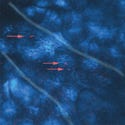Gold Illuminates Imaging Technology
Originally Published MDDI March 2006R&D DIGEST Heather Thompson
March 1, 2006
R&D DIGEST
|
Gold nanorods, which fluoresce red, were photographed inside the blood vessels of a live mouse by researchers at Purdue's Weldon School of Biomedical Engineering and department of chemistry. |
Gold nanorods that have been injected into the bloodstream could yield images that are nearly 60 times brighter than those seen using conventional fluorescent dyes, according to researchers at Purdue University's Weldon School of Biomedical Engineering (West Lafayette, IN). The technique involves shining a laser through the skin to detect the nanorods. Researchers hope the technique could be used to analyze blood vessels and underlying tissues for early cancer detection.
Current imaging technology does not work as effectively as it could, according to Alexander Wei, an associate professor. “One obstacle is that light in the visible spectrum does not pass through tissue very well,” he says. The team decided to use a laser to change the light being used in imaging.
Wei explains that a laser pulses in longer wavelengths of light, into the near-infrared spectrum. “In near infrared,” he says, “wavelengths measure from about 800 to 1300 nm.”
Because the nanorods have a certain aspect ratio of length to width, they shine brightly when lit by near infrared light. The gold rods are about 20 nm wide and 60 nm long, roughly 200 times smaller than a red blood cell.
Wei says these rods can be used for two-photon fluorescence to provide high contrast and bright images. Photons are the individual particles that make up light. In two-photon fluorescence, two photons hit the nanorod at the same time. The effect could enable the development of nonlinear optical techniques.
The researchers used mice in their experiments to test the imaging system. Nanorods were injected into a mouse's ears and two-photon fluorescence images were taken as the rods flowed through the blood vessels. The fluorescence from individual nanorods was about 58 times brighter in the images than from a single rhodamine molecule (a common imaging dye). After 30 minutes, the nanorods could not be detected, and the researchers concluded that they had been filtered out of the blood through the kidneys.
Because of the high degree of contrast, the researchers believe that using the nanorods, along with nonlinear imaging, will help identify cancerous tissue at an early stage. “To be able to detect cells at an early stage of a disease such as cancer, it is important to have a reliable technique that has sensitivity at the single-particle level,” Wei explains. “The gold nanorods demonstrate that nonlinear imaging methods are capable of this level of detection.”
The research has been funded by the National Institutes of Health and the Purdue Cancer Center. The research is affiliated with the Birck Nanotechnology Center and the Bindley Bioscience Center.
Copyright ©2006 Medical Device & Diagnostic Industry
About the Author(s)
You May Also Like



